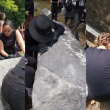CITIZEN SCIENCE FOR THE PROTECTION OF STECCI CULTURAL HERITAGE
10. Jul 2024
STECCI (STone monument Ensambles and the Climate Change Impact) project aim is to produce innovative and sustainable protection strategies for cultural heritage from the climate change and consequential natural hazards, environmental pollution and anthropogenic threats. The project is based on an overall co-creation process co-developing innovative approaches which embrace the social dimension of stecci cultural heritage in Croatia, Serbia, Bosnia Herzegovina, Montenegro and beyond. The Centre for Social Innovation in Vienna is responsible (among other) for the co-development and coordination of social labs and the citizen science activities in the five STECCI pilots.
The citizen science experiments are developed by the partner organisations Stiftung Preußischer Kulturbesitz (SPK) in Unsleben and Kleinbardorf in Lower Franconia in Germany and the Faculty of Science of the University of Novi Sad (UNSPMF) in Novi Sad in Serbia.
Both pilot projects conducted citizen science workshops with university students and volunteer researchers focusing on the impacts of climate change on nature and cultural heritage.
COLLECTING MEMORIES TO PROTECT CULTURAL HERITAGE
In Unsleben and Kleinbardorf, the Jewish cemeteries are the subjects of investigation. Here, SPK invited pupils aged 14 to 15 from a local grammar school to collect old family photographs that depict the surroundings and community from many years ago. This enabled the students to draw direct comparison of how the landscape and the gravestones have changed over time and how climate change is shaping the landscape. In further experiments, the influence of acid rain (sulphur dioxide) and flooding was demonstrated to give the students a clearer understanding of these impacts. Acid rain was simulated using various chemical substances s, and potential solutions were discussed in collaboration with the students. Further collaborations, including other schools, are planned.
CLIMATE CHANGE IMPACTS ON STONE HERITAGE AND BIODIVERSITY
Following a different approach but aiming at similar objectives, UNSPMF collaborated with an art school in Novi Sad, working with several students aged 17-18. This initiative primarily focused on the effects of acid rain on limestone and the extent to which climate change threatens local stone heritage. One of the students created small stećak models from clay, which were used in the experiments. These models helped to illustrate the impact of acid rain on the structure of the gravestones, and possible solutions were explored. In a follow-up workshop, UNSPMF identified 44 participants from the fields of microbiology, ecology and biology to conduct on-site investigations at the well-preserved Mramorje necropolis in Perućac. This necropolis was chosen because its location between the river Drina and the town of Perućac means that it is directly threatened by the effects of climate change and air pollution caused by the expansion of the town. As part of the workshop, the students took samples of the stones (biofilms, lichens or mosses) to map and subsequently analyse them. The aim was to illustrate the changes in biodiversity due to climate change in this necropolis.
In both citizen science experiments, it was particularly important to not only examine the impacts of climate change on stone heritage but also to raise awareness of these cultural assets and to focus more intensively on potential measures to protect them joining forces with members of the local communities.
Further information on the STECCI project is available on the project’s website…
The project no.101094822 is funded by .
Requests: Pamela Bartar, ZSI
stecci@zsi.at
Verwandte Artikel:
- News: Kick-off of the new STECCI project, turning necropoles into new opportunities
- News: Reviving history: “My STECCI Story” Workshops in Sarajevo, Split & Podgorica
- News: Reviving history: “My STECCI Stories” Workshop in Sarajevo & Kopošići
- News: BLENDING RELATIONAL AESTHETICS WITH CITIZEN SCIENCE IN STECCI
Tags: citizen science, climate change, co-creation, cultural heritage, social innovation, sustainability, sustainable toursim

















































